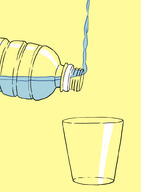1.4科学理论
章节大纲
-
Lesson
::经验教训What causes disease?
::是什么导致疾病?Today most people realize that microorganisms, such as bacteria or , are the cause of disease. This concept is known as the germ theory of disease, one of the few scientific theories in the field of the life sciences . Although it seems obvious now, people did not always understand the cause of disease. How does a theory such as this become established?
::今天,大多数人意识到微生物,如细菌或微生物,是疾病的原因。 这一概念被称为疾病细菌理论,这是生命科学领域为数不多的科学理论之一。 尽管现在似乎显而易见,但人们并不总能理解疾病的原因。 这种理论是如何建立的?Scientific Evidence and Theories
::科学证据和理论One goal of a scientist is to find answers to scientific questions. To do this, scientists first develop a hypothesis , which is a proposed explanation that tries to explain an observation . To collect evidence to support (or disprove) their hypothesis, scientists must do experiments . Evidence is:
::科学家的目标之一是找到科学问题的答案。 为此,科学家首先提出一个假设,即一个试图解释观察意见的拟议解释。为了收集证据来支持(或否定)他们的假设,科学家必须做实验。证据是:- A direct, physical observation of something or a process over time.
::一种直接的物理观察 某种东西或一个过程 随着时间的推移。
- Usually something measurable or "quantifiable."
::通常是可以测量的或者"可以量化的"
- The data resulting from an experiment.
::实验产生的数据。
For example, an apple falling to the ground is evidence in support of the law of gravity. A bear skeleton in the woods would be evidence of the presence of bears.
::例如,苹果落地就是支持重力定律的证据。 森林中的熊骨骼就是熊存在的证据。Looking at the image below might be confusing at first because this evidence seems to defy the law of gravity ( Figure ). Of course water cannot be poured out of bottle and flow upward. The law of gravity is a scientific law , which is a statement describing what always happens under certain conditions in nature. Scientific laws are developed from lots of collected information.
::观察下面的图象首先可能会引起混淆,因为这一证据似乎违背了重力法(图 ) 。 当然,水不能从瓶中倒出,也不能向上流。 重力法是一种科学法,它是一个描述在一定条件下自然发生的状况的说明。 科学法是根据大量收集的信息制定的。Water going upward against gravity.
::水从重力向上倾斜If many experiments are performed, and lots of evidence is collected in support of a general hypothesis, a scientific theory can be developed. Scientific theories are well established explanations of evidence, usually tested and confirmed by many different people. Scientific theories usually have a lot of evidence in support of the theory, and no evidence disproving the theory. Scientific theories produce information that helps us understand our world. For example, the idea that matter is made up of atoms is a scientific theory. Scientists accept this theory as a fundamental principle of basic science .
::如果进行了许多实验,并收集了大量证据来支持一般假设,那么科学理论是可以发展起来的。科学理论是证据的既定解释,通常由许多不同的人测试和确认。科学理论通常有许多证据支持理论,没有证据反驳理论。科学理论产生有助于我们理解我们世界的信息。例如,由原子组成的理论是一个科学理论。科学家们接受这一理论作为基础科学的基本原则。A scientific theory must stand up to all scientific testing. Thus, when scientists find new evidence, they can change their theories. In addition to the germ theory of disease, other scientific theories are the and the .
::科学理论必须抵制所有科学测试。 因此,当科学家发现新的证据时,他们可以改变理论。 除了疾病细菌理论之外,其他科学理论也是关键。Further Reading
::继续阅读Summary
::摘要- Evidence is a direct, physical observation of something or a process.
::证据是对某事或某一过程的直接、物理观察。
- Scientific theories are explanations of some aspect of the natural world based on repeated observations.
::科学理论是在反复观察的基础上解释自然世界的某些方面。
Explore More
::探索更多Use the resource below to answer the questions that follow.
::利用以下资源回答以下问题。- Scientific Theories at (4:43)
::科学理论(4:43)
- What happens to scientific ideas that do not match the natural world?
::与自然界不相匹配的科学思想会怎么样?
- In science, what is meant by a fact, a hypothesis, a theory, and a law?
::在科学中,一个事实、一个假设、一个理论和一个法律意味着什么?
- How do scientists' views of theories differ from the everyday use of these words?
::科学家对理论的看法与这些词汇的日常使用有何不同?
Review
::回顾- What is evidence?
::什么是证据?
- What is a scientific theory?
::什么是科学理论?
- What is a scientific law?
::什么是科学法?
- A direct, physical observation of something or a process over time.

